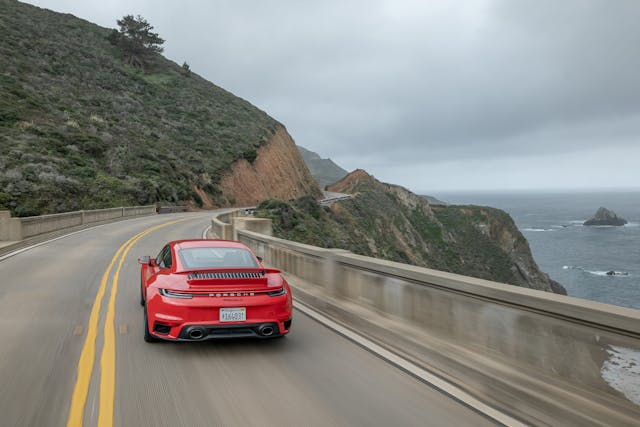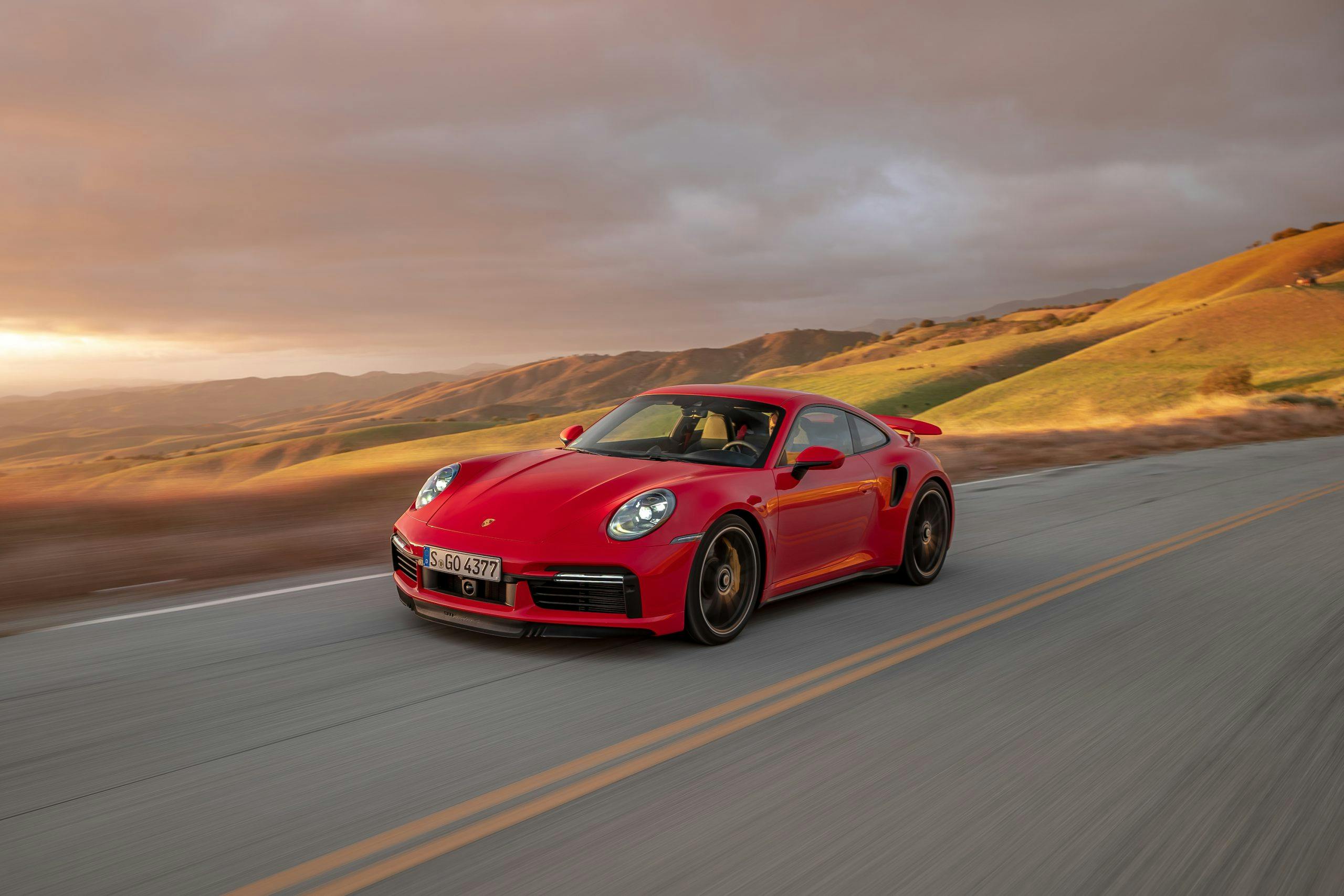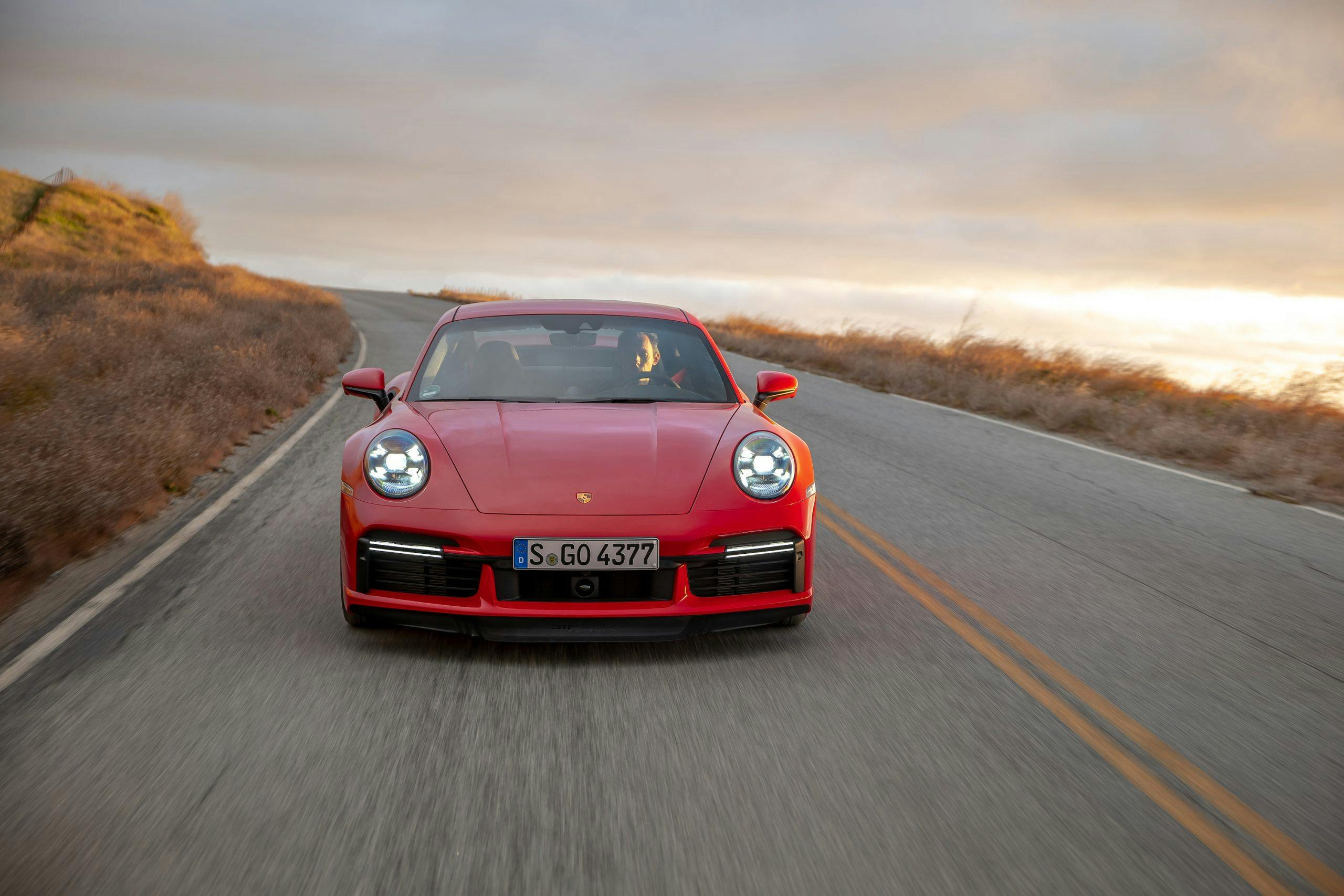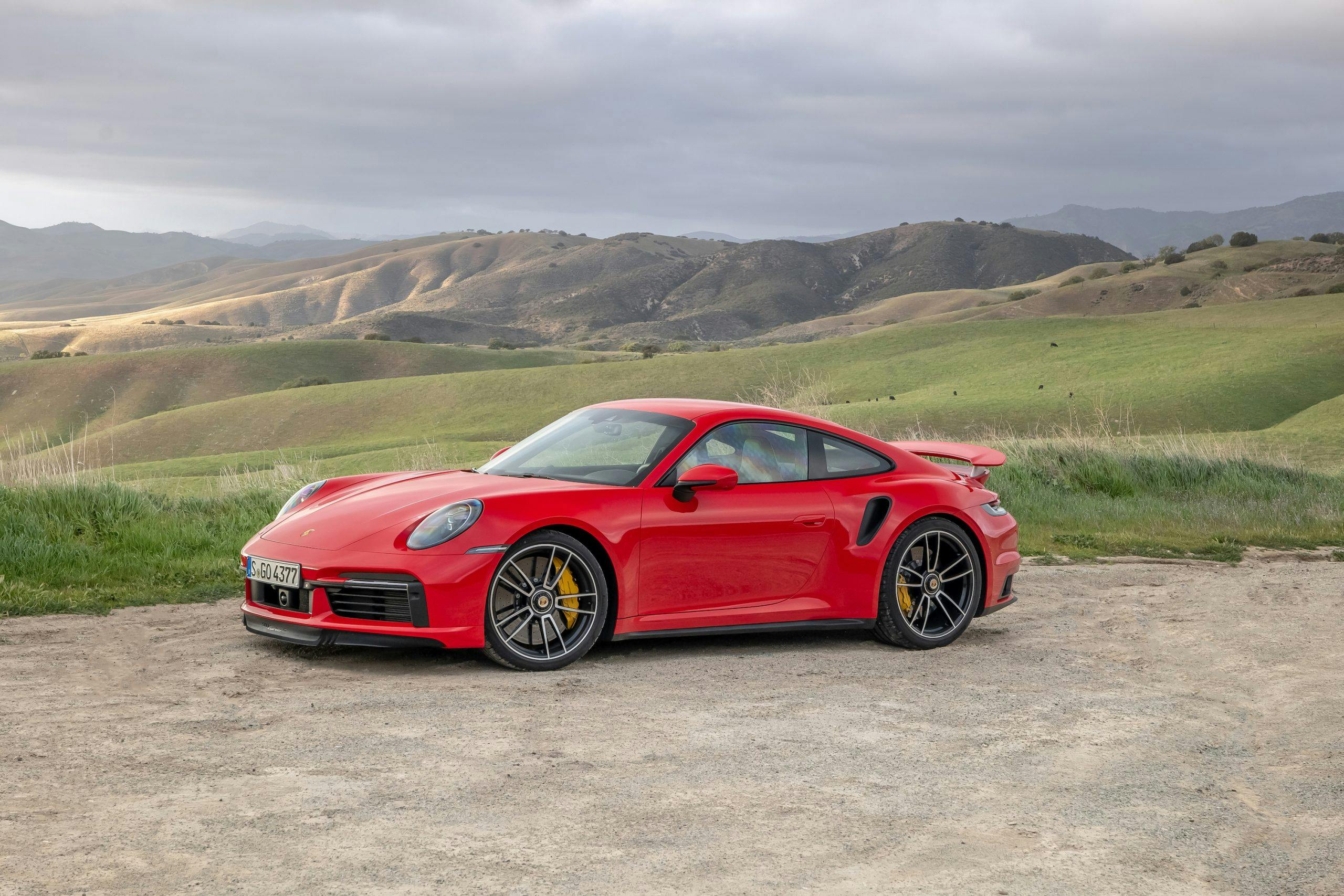Review: 2021 Porsche 911 Turbo S
In flying, the faster you go, generally, the less fun it is. A Piper Cub is a 70-mph epinephrine rush with your arm slung out the open window and your feet dancing on the pedals as you try to avoid the clouds of migrating murder hornets. Meanwhile, a guy in a barely-sub-mach biz jet flips on the autopilot 500 feet after wheels-up and lets the computer guide the missile to the target. In that realm, it’s all about arriving tout de suite. The new Porsche 911 Turbo S is a biz jet built for a world with endless runways.
It’s trite to say that the Porsche 911 is all grown up, but it is all grown up, an expensive gran turismo for people who aren’t ready to feel old driving the other posh rides in its price category. For one thing, the 911 is now physically huge. The new 992 generation is longer and wider than the old C7 Corvette. It is within a couple inches of the new C8 Corvette, which itself feels like it’s within a couple inches of the Royal Caribbean Rhapsody of the Seas. Park the 992 next to, say, a 993-generation model from the 1990s and it looks like the 911 that ate the other 911s.
All this enlarging is mainly for safety and comfort, as buyers of cars that start at $204,750, the base price of the Turbo S, don’t feel that they should have to make do without anything, including their own private ZIP codes. Pampering takes inches and pounds and motherboards, and subsequently wider and thicker and stiffer everything so it can all accelerate, stop, and corner at 1.0g-plus in all types of weather. And the new Turbo S does all of the above with ridiculous ease.

For those not keeping score, the 992 is the eighth generation of Porsche’s venerable 911 icon and it debuted in late 2018. Carrera S, 4S, and cabriolet variants have followed in the usual rollout cadence, and now the Turbo arrives as not the sportiest model—for those are the GT-series 911s—but as an all-wheel-drive, leathered-up executive express for crossing continents when the Gulfstream is broken. Unlike the GT models, the Turbo doesn’t come in electroluminescent colors (unless you force Porsche with your money to add one as a custom option), and the people who own them tend not to walk around in Alcantara racing shoes. It’s just not that kind of car.
Despite its rump-out reputation, the original 1976 U.S.-spec 911 Turbo was intended for the same audience, though at a time when luxury and performance expectations were much less. It had 234 horsepower, for example, 18 less than the turbocharged 2020 Chevrolet Equinox. The new 992 911 Turbo S has 640 horses worth of spin and 590 pound-feet worth of twist from the fusion reactor in its diaper. That’s enough for this 3600-pound meat-eater to grab 60 mph and wring its little neck in 2.6 seconds. It’s enough to drop a quarter-mile in 10.5 seconds and punch through to 205 mph. At least, if the factory stats are to be believed. Porsche is often conservative in this respect.
Changes to the 992-gen Turbo include a new 3.8-liter flat-six displacing 55 fewer cc than the previous engine but producing 60 more horsepower, in part due to larger turbo snails and the re-routing of hot exhaust gasses to improve breathing efficiency. The front and rear dimensions are somehow even wider than that of the outgoing car, and a new rear wing generates 15 percent more downforce while being one of two movable aero elements to go from reducing drag to reducing lift as speeds climb. The rear decklid has become a veritable BBQ grill of air slots, there are adaptive cooling air flaps up front, and the transmission is water-cooled and reinforced with steel plates to accept a bigger percentage of the engine torque when needed.
Precisely where are you going to exercise all that protein in the Turbo S? Well, never mind, a Porsche owner finds his or her moments to unleash. We found them up in the hills behind Malibu, California, after bombing a virus-cleared freeway at a shade over legal speeds. Though it’s a comfy mile-eater, the 911 is loud inside as those huge 315/30ZR-21-sized rear hams thrum the concrete. It may be priced like a Bentley Continental, but this is no Bentley Continental. It is a war machine wrapped in a thick blanket of Teutonic mod design.
Porsche has evolved the 911’s cockpit in the modern fashion, meaning it’s riddled with high-function multicolor screens which make the dash feel like one big computer console. The upside is that the army of small buttons that had been taking over Porsche cockpits in recent years has been greatly cleaned up, their functions migrated to the car’s internal cloud. The five-circle fan of instrument gauges that is a 911 character trait is still there, but they are all digitally rendered now, and they can be subbed out at command for moving nav maps or other data streams. Need to know the current weather? It can become a permanent fixture of your dash decoration if you so desire. Ditto the current album playing on your stream. It’s not quite a Tesla-style TV-room inside … yet. Things do seem to be headed in that direction, though.
A stubby toggle switch operates the eight-speed PDK (dual-clutch) transmission and, as with the rest of the car, engaging with it provides the sense of operating high-quality electronics rather than an automobile. Forget a manual transmission, that option in the Turbo model died with the dinosaurs. A few people will claim to miss it, but the vast majority of 911s of all stripes are sold with automatics.
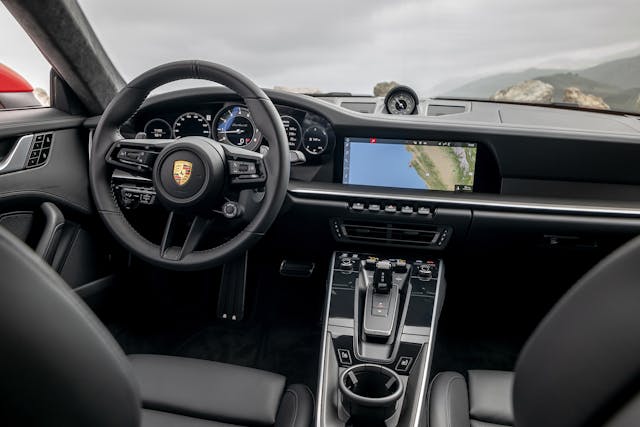
There’s so much torque from this engine, anyway, that two gears are enough for devouring mountain spaghetti. Paddle it up to fourth gear and just leave it there. You get all the turbo crazy out of a corner that you’ll ever need. Bang it into third if you need full bonkers and forget that the 911 Turbo S even has other gears. All stuffed up with boost, the boxer engine makes a muted whoosh even in full attack mode, sounding at all times more turbine than piston.
Electrically assisted, the steering cuts the road chatter down to almost nothing—face it, nobody wants steering wheels that dance around in your hands anymore—but it feels naturally weighted and precise enough to cut your lane into millimeter segments. You pick the line you want and the grip and computer brains running the torque-transfer system take you there while the suspension microchips furiously work the shock damping to keep the bounding inherent in older 911s to a minimum. Even the engine mounts have their own control software, selectively tamping down the movement of the big mass out back so that the engine no longer dictates the direction of a 911 out of a corner.
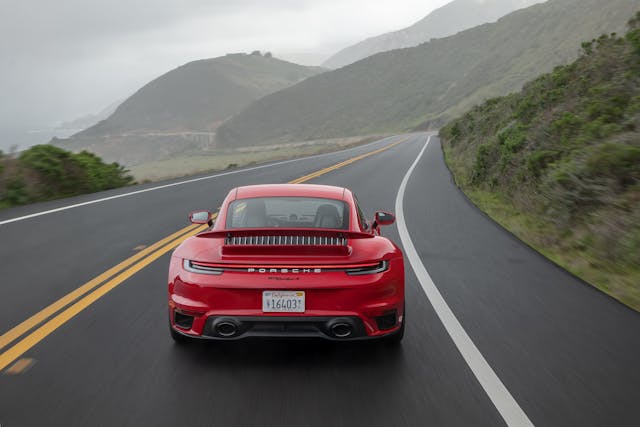
Ten (ten!) pistons in each front caliper clamp the front carbon-ceramic discs, 16.5 inches across. And the brakes are the most progressive of any 911 of recent memory. Typically, these cars have had stop pedals that are so hair-trigger that your author’s wife has blacklisted the entire model line because they give her motion sickness in ordinary traffic. Perhaps messages have gotten through to Stuttgart, because the new Turbo S allowed a more subtle finessing of its carbon brakes to a degree recent 911 generations never demonstrated.
It was damp in places the day we had the car, so we tried its “wet” mode. Usually the performance slackening is noticeable in such modes, accompanied by a distinct softening of the throttle and ratcheting up of the traction and stability control intervention. Not in the new Turbo. Whatever “wet” mode was doing, it was totally transparent. The car seemed just as ravenous for apexes as before but never hinted at losing grip despite our efforts to push it out of its comfort zone.
Which is the point. The Porsche 911 Turbo S has perhaps the widest comfort zone of any road car on the planet, made possible by all the horsepower, rubber, brake, driveshafts, software, and brainpower the modern auto industry can pile into one sports car. No wonder the thing has grown so large!
